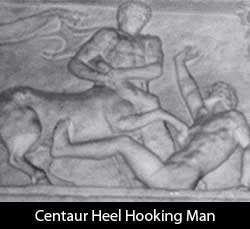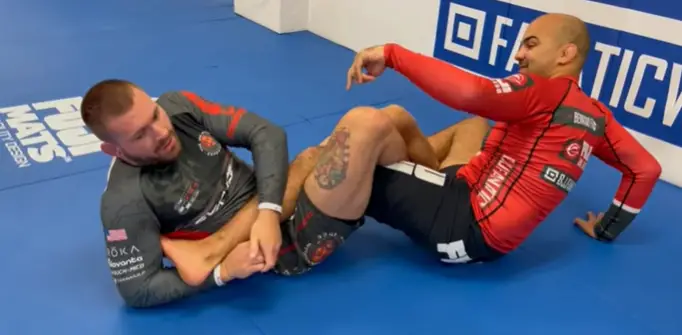You’d be forgiven for thinking that the heelhook is relatively modern submission given the recent explosion in the leglock game, particularly in No Gi grappling. The recent wave of expert leglockers like Gordon Ryan, Eddie Cummings, Ryan Hall, and Garry Tonon might be revolutionizing the game, but none of them can claim credit for inventing the submission itself. Not even the older generation of grapplers who are credited with laying the foundation those guys have built on, men like John Danaher and Dean Lister, were even alive when the heelhook was invented.
The first recorded use of a heelhook in the UFC was all the way back at the very first event when Ken Shamrock used a rather rudimentary leg entanglement to secure the finish against Patrick Smith. Watching this in comparison with Ryan Hall’s incredible finish of BJ Penn at UFC 232 can really give you a clear sense of how much the leglock game has evolved over the last two to three decades. Thousands of hours of work across hundreds of grapplers have gone in behind the scenes in order to develop this submission, and it’s setups and entries, but we’re looking even further back than this for it’s true beginnings.
Looking further beyond the 1990s is where history starts to get a little uncertain. Carlson Gracie once gave an interview with Marcelo Alonso of PVT where he made the following statement about the legendary grappler Ivan Gomes:
“He arrived in Rio for a fight and asked to stay and train with me. Later he traveled the world, and was the first Brazilian fighter to become a big star in Japan. The heelhook that we use today was created by him.”
While Carlson was incorrect in saying this, we can start to see how this submission made it’s way into our sport. Gomes was a competitive grappler in the 1960s and the decades that followed after this could be considered the dark ages of the leglock game in BJJ. When the first organisations started to set out rules for competition, the heelhook and leglocks in general were consistently outlawed and considered a rude or dirty tactic. For most BJJ competitors of that time, leglocks were seen as something that an unskilled practitioner would do instead of passing guard.
BJJ Heroes conducted an interview with Gomes’ younger brother Jose, a coral belt who trained with him up until Ivan’s death in 1990. In the piece, Jose quickly clears up Carlson’s mistake and clarifies that Ivan did not invent the submission, he learnt it from the brothers’ coach Jose Maria Freire originally. Gomes also explains that the passing of knowledge didn’t end there, as Freire was taught the heelhook by a Japanese Judoka, Takeo Yano and his student Builson Omar. Yano spent the first half of the twentieth century teaching and competing in the Northeastern part of Brazil, including fighting to a draw with Helio Gracie in 1937. He was not a traditional Kodokan Judoka however and instead came from the Japanese Imperial Navy, training in a Butokukai school.
While Yano seems as though he could be the man responsible for bringing the heelhook into Brazilian Jiu-Jitsu, the submission still existed long before the sport. While it’s not possible to trace the origins of the submission back further person-to-person, we can see evidence that it has existed essentially for as long as grappling has. Nektarios Lykiardopoulos’ book “The Martial Arts of Ancient Greece: Modern Fighting Techniques from the Age of Alexander” shows a heelhook being applied in an ancient Roman stone carving that can be found in the Vatican, although it’s exact age is uncertain. This could be as a result of the ancient art of Pankration which, despite being Greek in origin, was enjoyed by the Romans in equal measure after their invasions of Greece as far back as 146 BC.

The art of Pankration itself dates back at least as far as 648 BC when it was introduced into the 33rd Olympiad, although naturally it must have existed before it’s inclusion in the original version of the Olympic Games. The sport’s history prior to this isn’t recorded other than in Greek Mythology, as they believed that the ancient heroes Hercules and Theseus used techniques from the art to subdue mythical creatures. Much like modern MMA and sport BJJ, the ancient greek pankratiasts also started to develop specific areas of expertise and different styles as the years went on. They too had a number of athletes who began to specialize in getting underneath their opponents and using leglocks to earn a submission victory.
The only athlete of this kind that record exists of was a Cicilian competitor who went by the name of Halter. The story goes that Halter was a brave man and a good fighter, but was outsized by the majority of his opponents as the Greeks did not have weightclasses at the time. He then visited the home of the hero Protesilaos for advice on how to beat bigger opponents and was told “by being trampled upon”. He then discovered “the heel manoeuvre” and realised that this was what he was advised to use, as using leglocks from the bottom opened yourself up to strikes. Ancient greek literature also references two different styles: “the one who wrestles with the ankle” and “the one who wrestles with the heel” which points to the separation between what we call ankle locks and heelhooks in modern grappling.
Heelhooks can be traced back to at least 2,500 years ago and the ancient pankratiast Halter as the earliest named specialist, although this is by no means the end of the line. Most of human history has been lost to time and if it’s possible to place the submission as far back as above, it’s certainly possible that it dates back even further. After all, Halter must have learnt it from someone.
This piece is part of a series diving deep into the history of various submissions, click here to look through the rest of the series.













